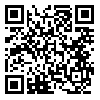BibTeX | RIS | EndNote | Medlars | ProCite | Reference Manager | RefWorks
Send citation to:
URL: http://ijhe.tums.ac.ir/article-1-5551-en.html
2- Associated Professor, Food Science and Technology Department, Health Faculty, Kermanshah University of Medical Sciences, Kermanshah, Iran ,
3- M.S of Nursing, Emam Reza Hospital, Kermanshah, Iran
4- B.S Student, Engineering Faculty, Razi University, Kermanshah, Iran
5- Instructor, Food Science and Technology Department, Health Faculty, Kermanshah University of Medical Sciences, Kermanshah, Iran
Background and Objectives: Money as a common tool is exchanged between people all over the world. Thus, it can be a source of chemical and biological contaminations causing serious diseases. The purpose of this research was to determine bacterial contamination of the currency notes and coins collected in Kermanshah.
Materials and Methods: 160 currency notes and 96 coins were randomly chosen from different jobs and parts of the city. Total count experiment was done and bacteria were identified and isolated through standard methods.
Results: Average total count in 1000, 2000, 5000, 10000, and 20000 Rials currency notes were 147.6, 147.8, 148.5, 96.3, and 87.9 and in 500, 1000, and 2000 Rials coins were 104.66, 77.66, and 96.56 CFU/cm2, respectively. The research showed that currency notes carries more bacterial load than coins (P<0.05). Additionally, contamination to E. coli on money (13.7 %) and on coins (3.9%) were at maximum levels while Pseudomonas on currency notes was at the minimum level (1.6%) and coins contained 0.2% Enterobacter that was at the lowest amount.
Conclusion: In summary, the most important microorganisms isolated from currency notes and coins (E.coli and Staphylococcus aureus) were pathogenic, causing serious food poisoning and gastroenteritis infectious. Therefore, preventing food from cross contamination with money is necessary.
Received: 2015/09/25 | Accepted: 2016/04/25 | Published: 2016/09/17
| Rights and Permissions | |
 |
This work is licensed under a Creative Commons Attribution-NonCommercial 4.0 International License. |





